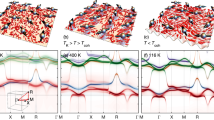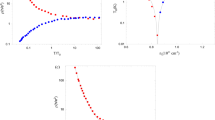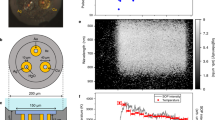Abstract
THE change of the electrical resistivity of pure metals at temperatures below 20° K. is of considerable theoretical importance. While there is available a great body of experimental data at the temperatures of liquid hydrogen and helium, only one set of experiments1 exists in the intervening region, which covers a 5 : 1 ratio in absolute temperature. Since for most metals the resistance becomes largely independent of temperature below 4° K., this region (between 4° and 20° K.) is crucial for determining the law of resistance variation with temperature. We have now modified a previously described helium cryostat2 working on the Simon expansion principle for continuous work between 1·5° and 20° K., temperatures being determined by a gas thermometer, and the electrical resistance with a sensitive galvanometer amplifier3.
This is a preview of subscription content, access via your institution
Access options
Subscribe to this journal
Receive 51 print issues and online access
$199.00 per year
only $3.90 per issue
Buy this article
- Purchase on SpringerLink
- Instant access to full article PDF
Prices may be subject to local taxes which are calculated during checkout
Similar content being viewed by others
References
de Haas and Van den Berg, Physica, 1, 609, 1115 (1933); 3, 440 (1936).
Daunt and Mendelssohn, Proc. Phys. Soc., 50, 525 (1938).
MacDonald, J. Sci. Instr., 24, 232 (1947).
Bloch, Z. Phys., 52, 555 (1928).
Grüneisen, Ann. d. Phys., 16, 530 (1933); Leipz. Vortr., 46 (1930).
Meissner and Voigt, Ann. d. Phys., 7, 761 (1930).
Cristescu and Simon, Z. Phys. Chem., B, 25, 273 (1934).
Pickard and Simon, Proc. Phys. Soc. (in the press).
Author information
Authors and Affiliations
Rights and permissions
About this article
Cite this article
MACDONALD, D., MENDELSSOHN, K. Electrical Resistivity of Alkali Metals Below 20° K. Nature 161, 972–973 (1948). https://doi.org/10.1038/161972a0
Issue date:
DOI: https://doi.org/10.1038/161972a0



